A Pro’s Guide To The Procedure Of Waterproofing Wizardry – Transforming Surfaces

Waterproofing isn’t about keeping your home dry during a rainy day. It is about safeguarding your investment and ensuring the longevity of your living space. Water can find its way into every nook and cranny of your property, from basements and roofs to bathrooms and balconies. This can cause expensive and dangerous issues if left unchecked. According to the Australian Institute of Waterproofing, waterproofing accounts for 1% of a building’s costs, yet water damage can cause significant damage and expenses.
This comprehensive guide will shed light on the procedures that play a key role in protecting your home from water damage. We will explore the Procedure of Waterproofing, breaking it down into manageable steps that anyone can follow. We’ll also explore the need to hire professionals for waterproofing projects and provide tips on selecting the right contractor.
So, whether you’re facing a pressing waterproofing issue or want to waterproofing contractors in Delhi you can book your call at keyvendors, this guide will equip you with the knowledge and tools you need to keep your home waterless and safe for years. Read on!
Table of Contents
Materials Required for Waterproofing Work Procedure
Here are some of the most common types of waterproofing materials:
1. Polyurethane: Polyurethane is considered one of the best waterproofing and crack injection materials. It can be applied easily and infiltrates the surface efficiently.
2. Cementitious Coating: Cementitious coating is a cement-based waterproofing material. This involves a mix of cement, sand, and proprietary chemicals. It is easy to apply and provides excellent adhesion to concrete surfaces.
3. Waterproofing Membrane: This is a thin, flexible sheet. It is made up of materials like bitumen, PVC, TPO, or EPDM. It’s applied to surfaces to create a waterproof barrier.
4. Geotextile Fabric: A protective layer between the waterproofing membrane and the substrate. It helps in drainage and provides extra protection.
5. Caulk/Sealant: Caulk or sealant seals joints, gaps, and cracks. It prevents water intrusion in vulnerable areas like corners and penetrations.
Tools Required For Work Procedure of Waterproofing
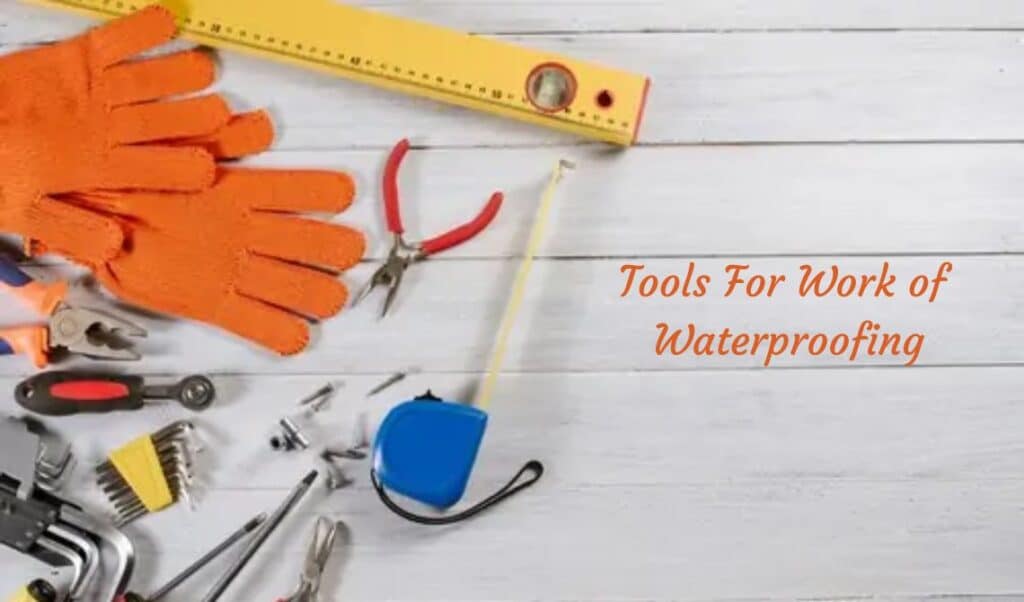
Here’s a list of tools and materials required for Waterproofing Work Procedure:
1. Safety Gear:
- Safety goggles
- Gloves
- Respirator mask
- Protective clothing
2. Surface Preparation:
- Wire brush
- Power washer or pressure washer
- Scraper or putty knife
- Cleaning agents or solvents
3. Applicators:
- Paintbrushes
- Rollers
- Trowels
- Spray equipment
4. Tools for Concrete Repair:
- Concrete saw or grinder
- Hammer and chisel
- Concrete mix and mixing tools
5. Crack Repair:
- Injection kit
- Caulking gun
6. Measuring and Marking:
- Measuring tape
- Level
- Marking tools (pencils, chalk lines)
7. Cleanup Supplies:
- Rags or sponges
- Buckets
- Water for cleaning
8. Ladders and Scaffolding:(Depending on the project’s height and accessibility)
9. Water Test Equipment: (To test the effectiveness of the waterproofing)
10. Safety Equipment:
- Fire extinguisher
- First aid kit
Toilet/Bathroom Waterproofing Procedure
A toilet waterproofing procedure requires specialized knowledge and experience. This will ensure that the waterproofing is done correctly and will last long. Below is a step-by-step guide for Toilet/Bathroom Waterproofing Procedure.
- Apply primer to the cleaned floor and walls of the toilet area. Also, fill any gaps or cracks in the floor and walls with a waterproof sealant.
- Apply a waterproofing membrane to the floor and walls of the toilet area with a paint roller or brush.
- Ensure the waterproofing membrane covers the toilet drain. Also, ensure enough overlap between the membrane pieces and allow it to dry.
- Apply a second coat of waterproofing membrane to the floor and walls of the toilet area. Allow it to dry before proceeding.
- Apply a final coat of waterproofing membrane to the floor and walls of the toilet area.
Procedure of Waterproofing Terrace
Here is a step-by-step guide for the terrace waterproofing of procedure:
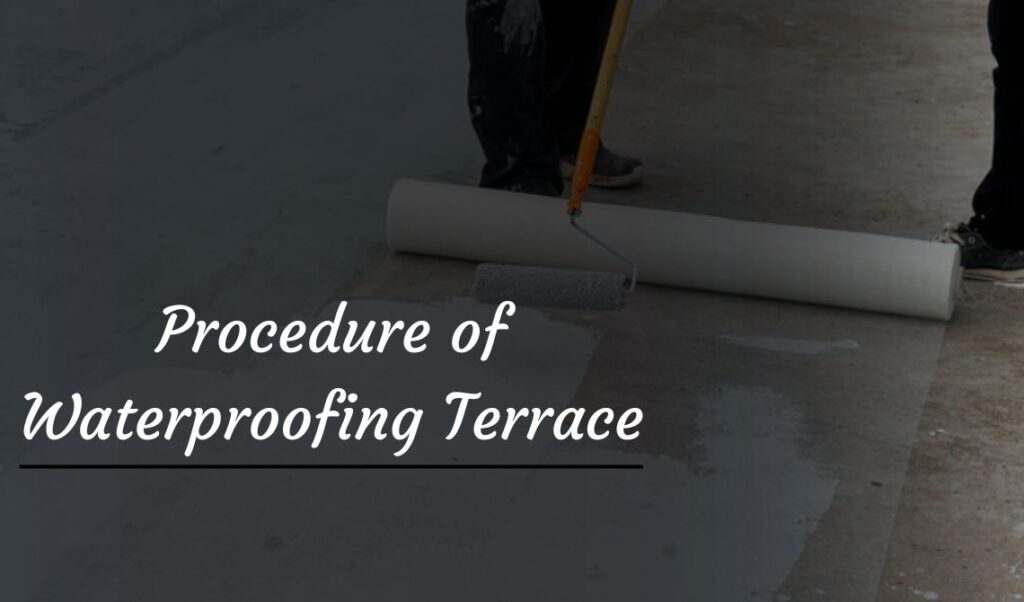
- Check the condition of the visible layer of flooring (the top part you can see).
- Clean the terrace roof.
- Repair or strengthen the weakened substrate by removing the loose concrete or plaster and re-plastering or re-concreting.
- Apply polymer-modified cementitious slurry coatings over the base concrete.
- Allow the coating to dry completely before applying the next coat.
- Check for any leaks or cracks and repair them if necessary.
- Apply a final coat of waterproofing material to seal the terrace.
Sloping Roof & Chajjas Water Proofing Procedure
Sloping roof and chajjas water proofing procedure:
- Clean the roof and check for leaks.
- Apply primer and waterproofing material to chajjas.
- Apply a topcoat to the roof surface.
- Inspect the roof for any missed spots or areas that need touch-ups.
Basement Swimming Pool Waterproofing of Procedure
To ensure the pool is waterproof and free from leaks, here are the steps to follow:
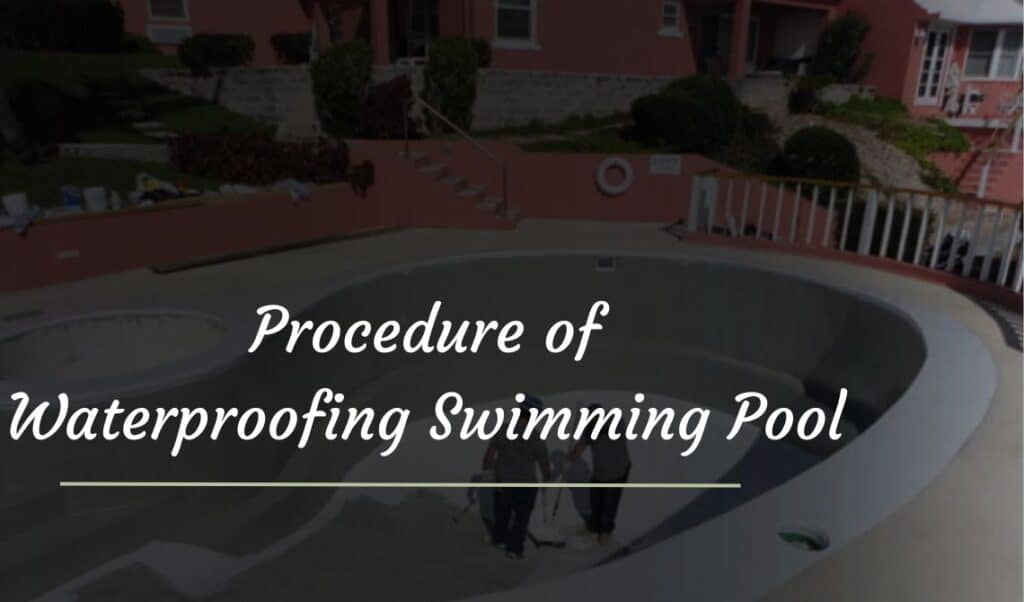
- Clean the substrate and smoothen it from any bumps or rough spots.
- Apply the waterproofing membrane.
- Test for leaks.
Also, proper coverage and a minimum of two coats are required for warranty waterproofing. It is also recommended to tape along the concrete floor 1 inch out from the base of the wall.
Procedure of Construction Basement Waterproofing
Here is a step-by-step guide for constructing basement waterproofing:
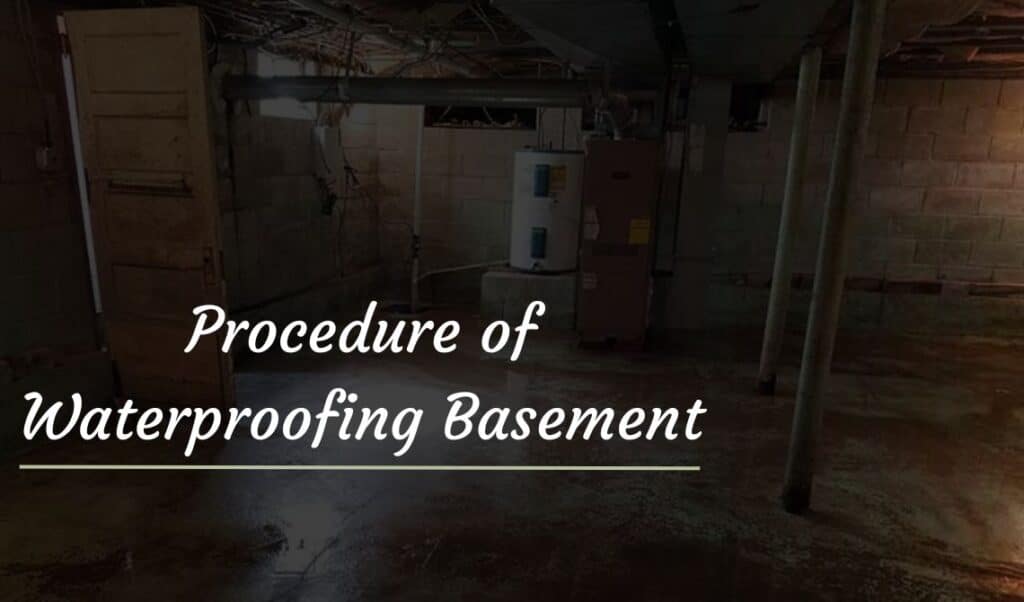
- Specify the finished height of the foundation above grade and mark the waterproofing line. Don’t go lower than six inches below the finish grade.
- Dig around the foundation to expose the exterior walls.
- Check for cracks in the foundation walls and repair them.
- Apply a sealant to the foundation walls to prevent water from seeping through.
- Apply a membrane to the foundation walls to provide more protection.
- Install a drainage mat to let water flow away from the foundation walls.
- Fill in the weeping tile with 16 inches of gravel.
- Fill up the excavation area with soil.
Underground Water Tank Waterproofing Work Procedure
Here is a step-by-step guide for the Underground Water Tank Waterproofing Work Procedure:
- Excavate the ground and constantly dewater the area to keep it dry.
- Do stone soling and lay lean concrete.
- Apply 2 coats of Waterproofing Membrane over the lean concrete surface.
- Repair the concrete and apply Water Guard Crysta Coat 101 over the surface of the concrete internally and externally.
- Finish the external and internal plaster of the underground tank slightly rough.
- Plaster all the areas of the underground tank internally and externally.
- Cover the weeping tile with 16 inches of gravel and backfill the excavation area with soil.
- Ensure the tank is empty and completely dry before waterproofing.
- Apply a waterproofing material over the concrete surface of the underground tank.
- Ensure that the external and internal plaster of the underground tank is finished slightly rough.
- Apply a second coat of waterproofing material over the rough plaster.
- Test the tank for leaks and make any necessary repairs.
Overhead Water Tank Waterproofing Procedure
Here is a step-by-step guide for overhead water tank waterproofing work procedure:
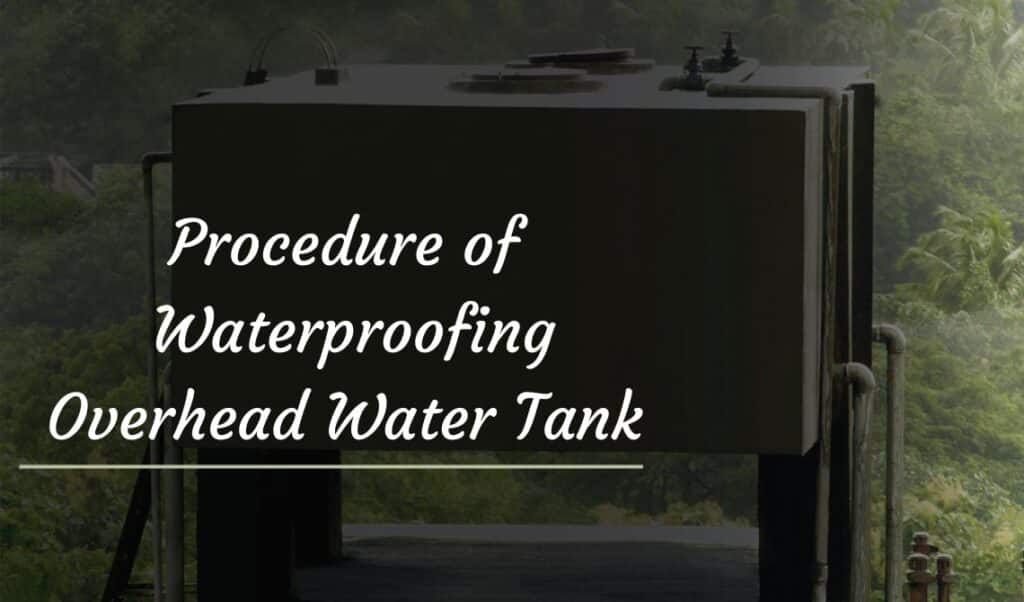
- Empty the water tank and make sure it is completely dry.
- Clean the tank’s surface from grease residues, dust, loose materials, etc.
- Repair any cracks or damages in the concrete surface of the tank.
- Apply a heavy stripe coat where movement is anticipated around details, over joints, large cracks, etc.
- Apply two coats of waterproofing membrane over the surface of the concrete.
- Finish the external and internal plaster of the tank slightly rough. Expose some grains using a foam (Foam finish plaster).
Conclusion for Procedure of Waterproofing
Understanding the Waterproofing Procedure is essential for preserving buildings’ structural integrity and longevity. By following the steps this blog outlines, you can ensure a watertight environment that stands the test of time. Crystalline waterproofing is a technique that creates a self-sealing barrier within the concrete. This process is often used to waterproof below-grade structures. It is also an eco-friendly solution since it does not involve using harmful chemicals or heavy equipment. Remember, proper waterproofing safeguards your property and provides peace of mind.
FAQs: About Procedure of Waterproofing
What is the procedure of waterproofing?
According to Wikipedia, Waterproofing is the process of making a structure water-resistant so that it stays unaffected by water and the ingress of water under specified conditions.
How long does waterproofing need to be set?
The curing time for waterproofing can vary depending on the type and environmental conditions. According to LATICRETE, it would be set for at least 14 days at 70°F.
Where is waterproofing necessary?
Any structure area that can be exposed to moisture should be waterproofed. Examples include showers, floors and walls next to baths, etc
Which material is used for waterproofing?
Materials mostly used for waterproofing include Thermoplastic Olefin, Bitumen, Cementitious coatings, sheet membranes, etc.
